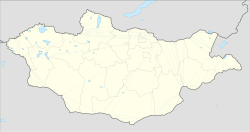Amarbayasgalant Monastery
| ᠠᠮᠤᠷ ᠪᠠᠶᠠᠰᠬᠤᠯᠠᠩᠲᠤ ᠬᠡᠶᠢᠳ Амарбаясгалант хийд 慶寧寺 | |
|---|---|
Baruunbüren Sum, Selenge Province, Mongolia | |
| Country | Mongolia |
| Geographic coordinates | 49°28′48″N 105°05′06″E / 49.48000°N 105.08500°E |
| Architecture | |
| Style | Chinese, Mongol and Tibetan influences |
| Date established | 1727 |
Amarbayasgalant Monastery (

The monastery was established and funded by order of the
Amarbayasgalant monastery is dedicated to Zanabazar's main tutelary deity,
Amarbayasgalant was one of the very few monasteries to have partly escaped destruction during the Stalinist purges of 1937, after which only the buildings of the central section remained. Many of the monks were executed by the country's Communist regime and the monastery's artifacts, including thangkas, statues, and manuscripts were looted, although some were hidden until more fortunate times.
Today, only 28 temples remain. Restoration work began in 1988 with funds provided by UNESCO and private sources and some of the new statuary was commissioned in New Delhi, India.
References
- ISBN 9622177166.
- ^ Van Vleet, Stacey. "Zanabazar Jebtsundampa Khutukhtu". Lamas-and-emperors. Retrieved 12 October 2015.
External links
![]() Media related to Amarbayasgalant Monastery at Wikimedia Commons
Media related to Amarbayasgalant Monastery at Wikimedia Commons

